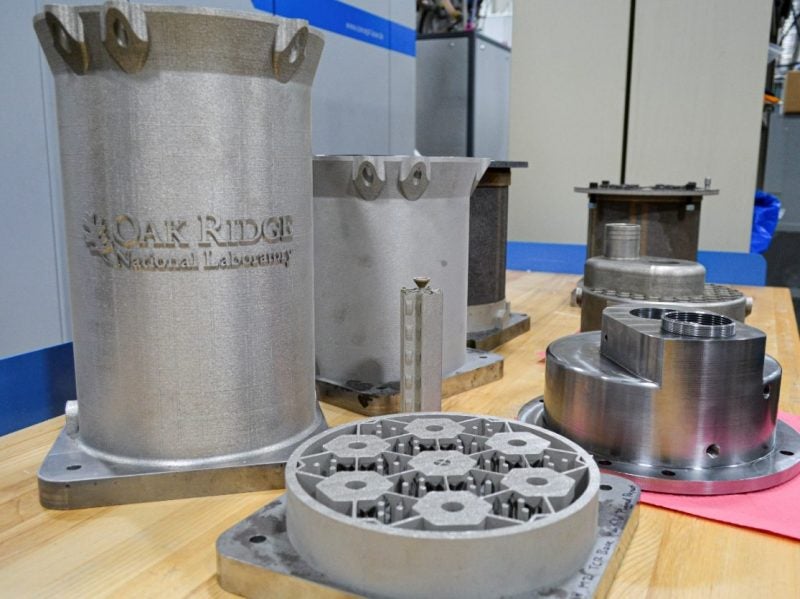
Nuclear power is in the midst of a crisis. In 20 years, only one nuclear plant has been built in the US and in Western Europe. Countries are either phasing out the technology altogether or commissioned projects are experiencing rising costs and endless days. Furthermore, the shift away from large-scale base-power to intermittent renewables is raising questions about nuclear powers’ relevance in the future.
“We’ve lost the will or don’t know how to design, build, and deploy nuclear systems as we did previously in the 50s, 60s, and 70s – we haven’t built a non-water-cooled advanced reactor in about 40 years,” says Kurt Terrani, a senior staff scientist at Oak Ridge National Laboratory.
An ongoing research project at the laboratory, called the Transformational Challenge Reactor Program, of which Terrani is a technical director, is aimed at changing this depressing fact. It is working with material, computational, and manufacturing sciences, as well as 3D printing, artificial intelligence, and big data to advance reactor core design.
“We want to exploit these technological advances and the best new materials to show we can deliver better, safer systems that can be deployed more quickly,” says Terrani.
He goes further, explaining the need for innovation in the nuclear industry:“I’m very suspicious of nuclear engineers because they haven’t delivered anything new in the last 40 years, but if you look at natural gas technology, these guys have been innovating.
“If you’re a utility chief financial officer, it’s kind of insane to go ahead and take a bet on nuclear, whereas gas has a very low capital cost. We need more efficient, better systems. Our dream is to break the abstinence from building advanced reactors in this country [the US].”
Addressing the cost problem
Perhaps most concerning is how the costs for nuclear have skyrocketed. The Hinkley Point C nuclear power station in the UK, for example, is expected to cost an eye-watering £22bn.
To address the cost problem, researchers at Oak Ridge, the largest science and energy national laboratory in the Department of Energy system , are refining their design of a 3D printed gas pipe to reactor core that can use scaled up additive manufacturing for construction. The prototype is a ‘micro’ three megawatts reactor.
Using a 3D printing methodology, developed during a past programme, it can print using silicon carbide, which is a refractory, a material with high temperature and radiation resistance.
“3D printing allows us to achieve high complexity of design, such as for cooling channels, using some high-performance materials, which wasn’t possible before. For example, using a material like silicon carbide, we can significantly increase the performance and safety of our core,” explains Terrani.
Ensuring quality assurance
Additionally, 3D printing facilitates building at small volumes and with ‘hybrid’ structures. This means, instead of using a chunk of a single material, such as steel, the researchers can embed and incorporate other components into the material, specifically sensors.
“By incorporating and embedding sensing and sensors into the structures, we can extract much more information from our system, such as health monitoring. This allows us to get more data from the system overall, which is important to reduce operational costs because it creates a more reliable system, with better monitoring information, meaning more processes can be automated,” Terrani explains.
This can also improve the qualification and quality assurance of the technology due to the ability to scrutinise how materials are made and whether they meet the performance criteria.
“Qualification usually takes a lot of time and requires many people and when you have a nuclear stamp on a component that cost is even higher. But because we are doing 3D printing in small volumes, we can collect information as we’re doing it, we can record it with cameras, use sensing and other things to collect information across lots of different parameters,” says Terrani.
The researchers are collecting ‘a few hundred gigabytes’ of data sets, which are used with artificial intelligence to search for critical performance parameters. This information is then used to determine if, once a part is made, it meets the necessary quality standards, which is a big cost component for nuclear systems.
Researchers also plan to create a digital platform that will help the industry adopt additive manufactured nuclear energy technology.
Securing the future of nuclear
Terrani says that designing reactors in this way is different to what he refers to as creating ‘paper reactors that work on computers but which nobody can actually build’.
“We are trying an agile, iterative, and dynamic approach that lends itself to multidisciplinary projects. Instead of doing many months or years of design, we do days and weeks of design, which we then 3D print,” he says. “Then, from the prototype, we can measure properties and performance parameters and feed it directly back into the design.”
It is also possible that deploying advanced technologies such as AI and 3D printing could attract a new generation of nuclear engineers.
“Certainly, having these advanced technologies is a carrot for the younger generation, but we’re also bringing in computer scientists and material scientists and manufacturing specialists,” says Terrani.
The Oak Ridge lab aims to turn on the first-of-its-kind reactor by 2023. Currently, it is focused on refining the selected design and the processes that will ensure an optimal and reliable energy system.
Eventually, Terrani hopes the project will provide another ‘tool’ for the developer’s ‘toolbox’.
“The essence of this programme is to create better nuclear reactors, with lower costs and better safety – but also build them,” concludes Terrani.
“I’m personally frustrated and tired that every other industry is using advanced technology and in nuclear we’re not good at leveraging them; we hope we can open the door.”



